Atkinson K. An Introduction to Numerical Analysis
Подождите немного. Документ загружается.

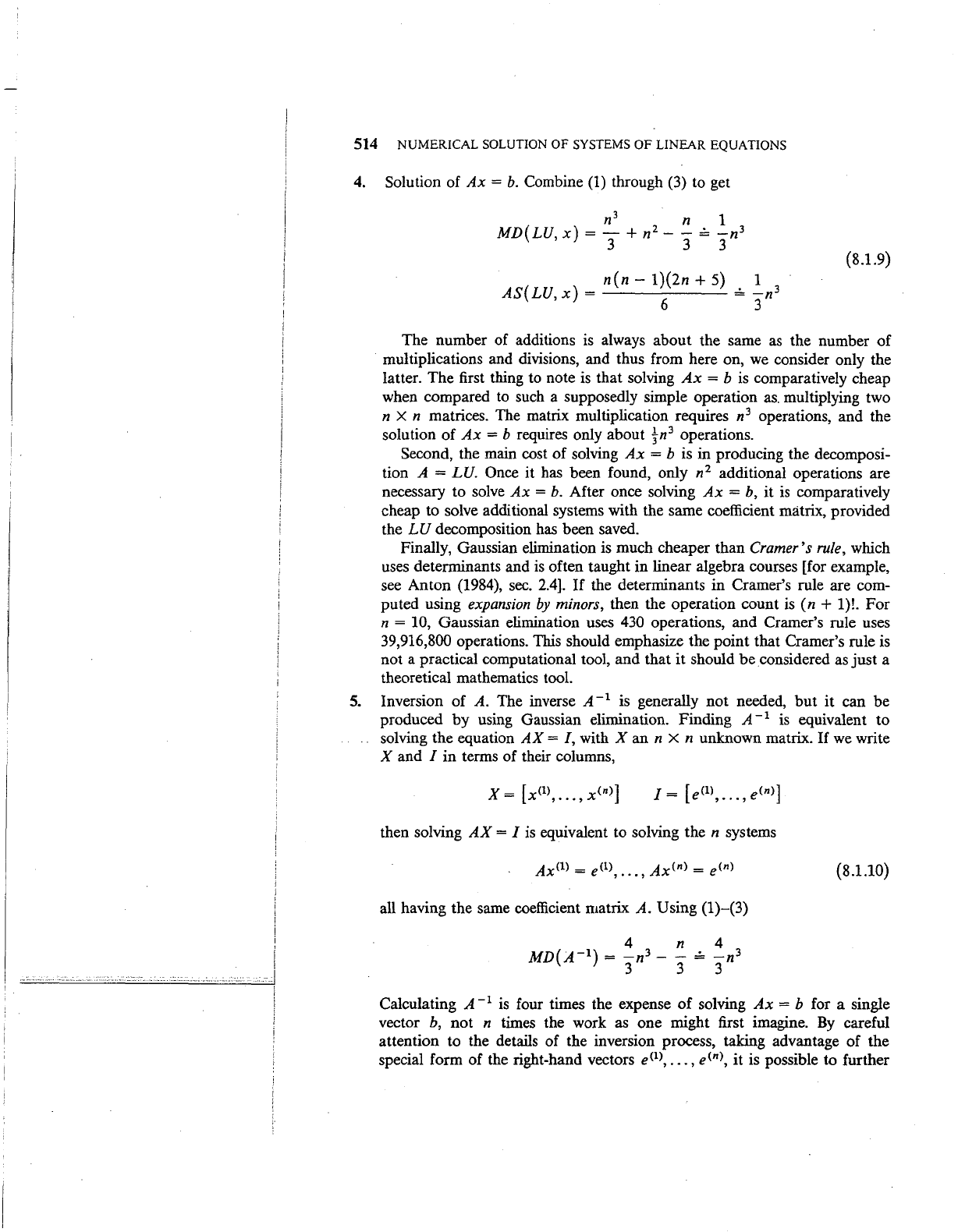
---·--·· . -······--··
.......
--·--·-·
:·:
..
.
~:
..
·.:.
".'.:.·.:
..
·
..
:
__
:
_:_
_____
~
....
·.
::·
I
I
I
I
i
I
I
i
I
I
.·.•.·I
514 NUMERICAL SOLUTION OF SYSTEMS OF LINEAR EQUATIONS
4.
Solution of
Ax
=
b.
Combine
(1)
through (3)
to
get
n
3
n 1
MD(LU
x)
= - + n
2
-
-
,;,
-n
3
' 3 3 3
(8.1.9)
n(n-
1)(2n +
5)
1
AS(LU
x)
= =
-n
3
' 6 3
The number of additions
is
always about the same
as
the number of
multiplications and divisions, and thus from here on,
we
consider only the
latter. The first thing to note
is
that solving
Ax
= b is comparatively cheap
when compared
to
such a supposedly simple operation
as.
multiplying two
n X n matrices. The matrix multiplication requires n
3
operations, and the
solution of
Ax
= b requires only about
tn
3
operations.
Second, the main cost of solving
Ax=
b is in producing the decomposi-
tion
A = LU. Once
it
has been found, only n
2
additional operations are
necessary to solve
Ax
=
b.
After once solving
Ax
=
b,
it
is
comparatively
cheap to solve additional systems with the same coefficient matrix, provided
the
LU
decomposition has been saved.
Finally, Gaussian elimination is much cheaper than
Cramer's
rule,
which
uses determinants and
is
often taught in linear algebra courses [for example,
see Anton (1984),
sec.
2.4].
If
the determinants in Cramer's rule are com-
puted using
expansion
by
minors, then the operation count
is
(n + 1)!.
For
n =
10,
Gaussian elimination uses
430
operations, and Cramer's rule uses
39,916,800 operations. This should emphasize the point that Cramer's rule is
not a practical computational tool, and that it should
be
considered as
just
a
theoretical mathematics tool.
5.
Inversion of A. The inverse A -
1
is generally not needed,
but
it
can be
produced by using Gaussian elimination. Finding
A -
1
is
equivalent to
solving the equation
AX
=
I,
with X an n X n unknown matrix.
If
we
write
X and I in terms of their columns,
1=
[e(l),
...
,e<n>]
then solving
AX=
I
is
equivalent to solving the n systems
Ax<
1
> =
e<
1
>,
..• ,
Ax<n>
=
e<n>
(8.1.10)
all having the same coefficient matrix
A. Using (1)-(3)
Calculating
A
-l
is
four times the expense
of
solving
Ax
= b for a single
vector
b,
not n times the work as one might first imagine.
By
careful
attention to the details of the inversion process, taking advantage of the
special form of the right-hand vectors
e<
1
>,
.•• ,
e<n>,
it is possible to further
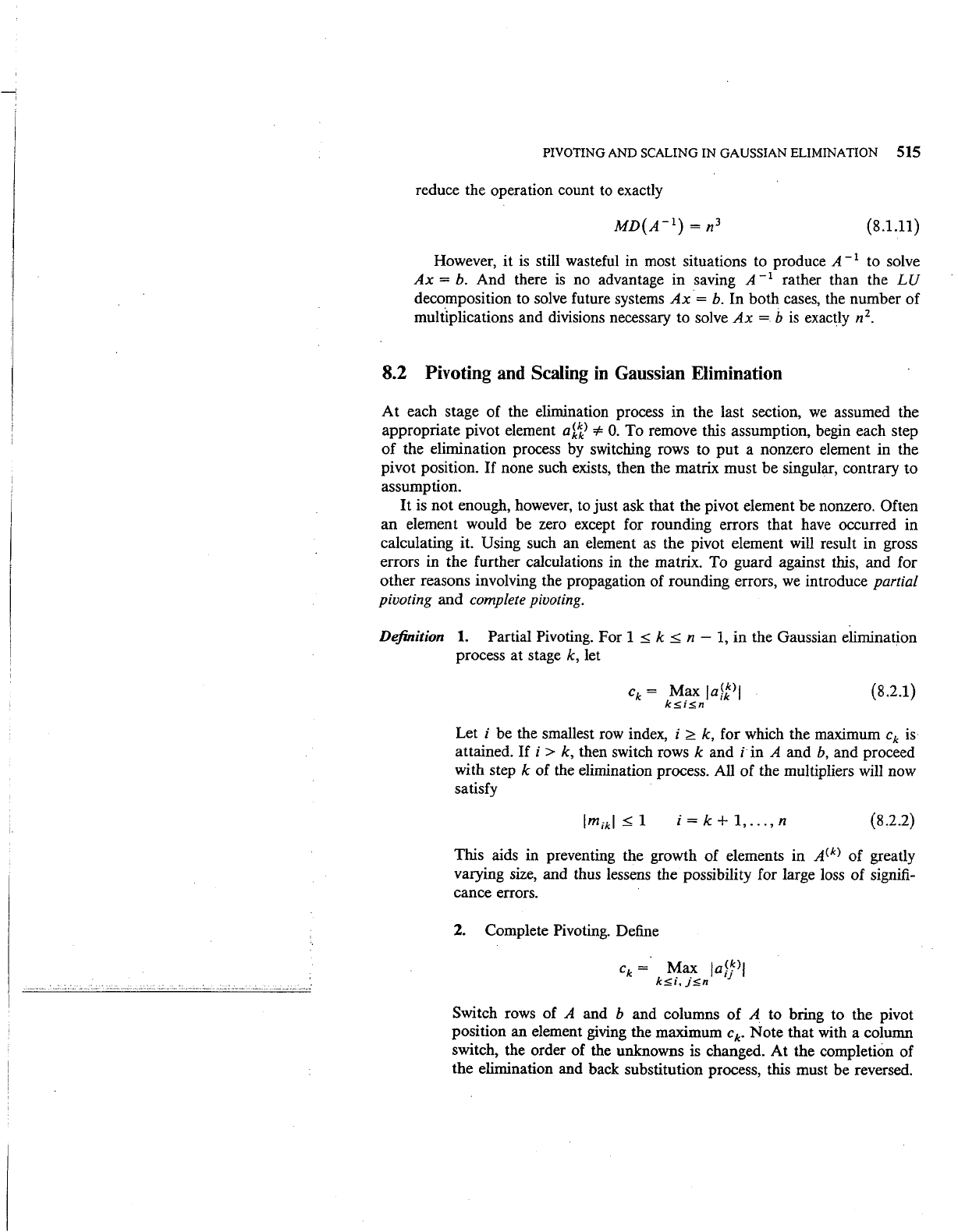
PIVOTING AND SCALING IN GAUSSIAN ELIMINATION 515
reduce the operation count
to
exactly
(8.1.11)
However, it
is
still wasteful in most situations to produce A -
1
to solve
Ax=
b. And there
is
no advantage
in
saving A -
1
rather than the
LU
decomposition to solve future systems
Ax
=
b.
In both cases, the number of
multiplications and divisions necessary to solve
Ax
= b
is
exactly n
2
•
8.2 Pivoting and Scaling
in
Gaussian Elimination
At
each stage of the elimination process
in
the last section,
we
assumed the
appropriate pivot element
aW
i=
0.
To remove this assumption, begin each step
of
the elimination process by switching rows to
put
a nonzero element in the
pivot position.
If
none such exists, then the matrix must be singular, contrary to
assumption.
It
is not enough, however, to just ask that the pivot element be nonzero. Often
an element would be zero except for rounding errors that have occurred in
calculating it.
Using such an element
as
the pivot element will result in gross
errors in the further calculations in the matrix. To guard against this, and for
other reasons involving the propagation of rounding errors,
we
introduce partial
pivoting and complete pivoting.
Definition
1.
Partial Pivoting. For 1
.::;;
k
.::;;
n -
1,
in
the Gaussian elimination
process at stage
k,
let
(8.2.1)
Let i be the smallest
row
index, i
~
k, for which the maximum ck
is
attained.
If
i > k, then switch rows k and i in A and
b,
and proceed
with step
k of the elimination process. All of the multipliers will now
satisfy
i = k + 1,
...
, n (8.2.2)
This aids in preventing the growth of elements in
A(k)
of greatly
varying
size,
and thus lessens the possibility for large loss of signifi-
cance errors.
2. Complete Pivoting. Define
Switch rows of
A and b and columns of A to bring to the pivot
position an element giving the maximum
ck. Note that with a column
switch, the order of the unknowns is changed.
At
the completion of
the elimination and back substitution process, this must be reversed.
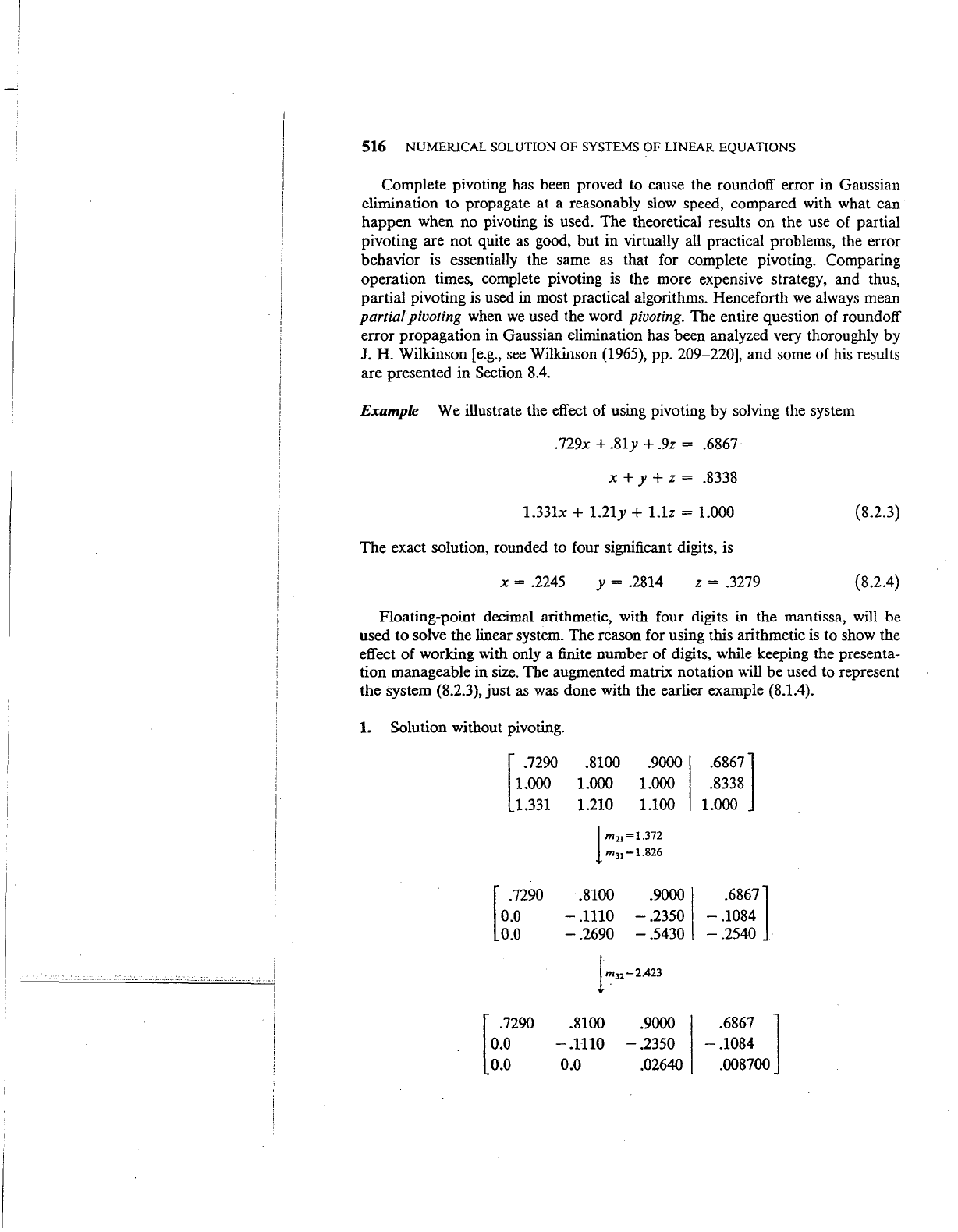
······-·"·····--·-
.:
-
...
:~:
·:
..
~.·-·
. - .....
-··
.:_.
516 NUMERICAL SOLUTION OF SYSTEMS OF LINEAR EQUATIONS
Complete pivoting has been proved to cause the roundoff error in Gaussian
elimination to propagate at a reasonably slow speed, compared with what can
happen when no pivoting
is
used. The theoretical results on the use of partial
pivoting are not quite
as
good, but in virtually all practical problems, the error
behavior is essentially the same as that for complete pivoting. Comparing
operation times, complete pivoting
is
the more expensive strategy, and thus,
partial pivoting
is
used in most practical algorithms. Henceforth
we
always mean
partial pivoting when
we
used the word pivoting. The entire question of roundoff
error propagation
in
Gaussian elimination has been analyzed very thoroughly by
J. H. Wilkinson
[e.g.,
see
Wilkinson (1965), pp. 209-220], and some of his results
are presented in Section
8.4.
Example
We illustrate the effect of using pivoting by solving the system
.729x +
.8ly
+ .9z = .6867
X + y + Z = .8338
1.331x
+ 1.21y + 1.1z = 1.000
The
exact solution, rounded to four significant digits, is
X=
.2245
y = .2814 z = .3279
(8.2.3)
(8.2.4)
Floating-point decimal arithmetic, with four digits in the mantissa, will be
used
to
solve the linear system. The reason for using this arithmetic
is
to show the
effect of working with only a finite number of digits, while keeping the presenta-
tion manageable in
size.
The augmented matrix notation will be used to represent
the system (8.2.3), just
as
was done with the earlier example (8.1.4).
1. Solution without pivoting.
[
.7290
1.000
1.331
[
.7290
0.0
0.0
.8100 .9000
1.000 1.000
1.210 1.100
l
m
21
=1.372
m3
1
-1.826
.8100 .9000
-.1110
-.2350
-.2690
-.5430
lm
32
=2.423
.8100
.9000
0.0
[
.7290
-.H10
-.2350
0.0 0.0 .02640
.6867]
.8338
1.000
.6867]
-.1084
-.2540
.6867 l
-.1084
.008700
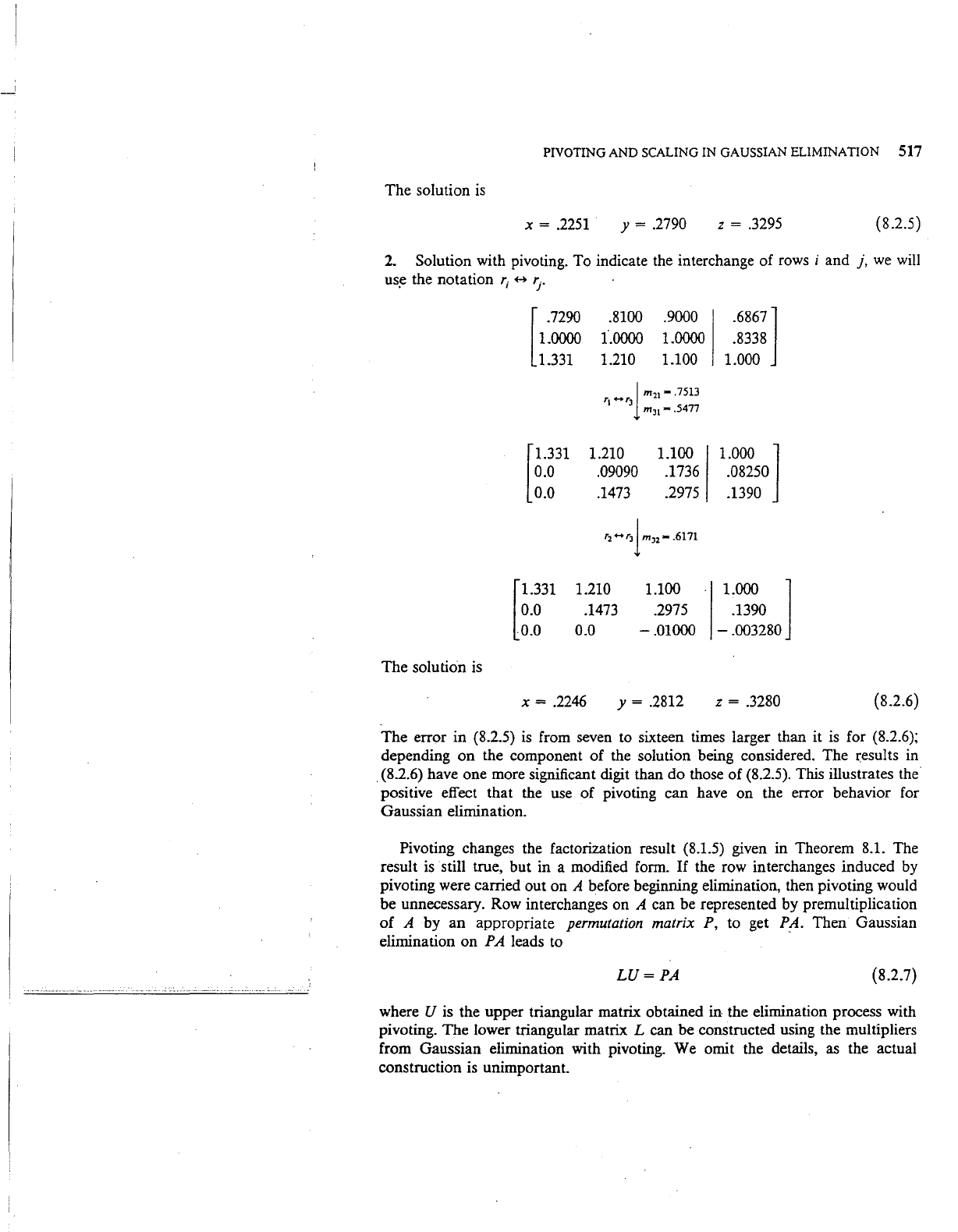
PIVOTING AND SCALING IN GAUSSIAN ELIMINATION 517
The solution
is
X=
.2251
y = .2790
z =
.3295
{8.2.5)
2.
Solution with pivoting. To indicate the interchange of rows i and
j,
we
will
us~
the notation r;
~
rj.
The error in (8.2.5)
is
from seven to sixteen times larger than it
is
for (8.2.6);
depending on the component of the solution being considered. The
r:esults
in
. (8.2.6) have one more significant digit than do those of (8.2.5). This illustrates the
positive effect that the use of pivoting can have on the error behavior for
Gaussian elimination.
Pivoting changes the factorization result (8.1.5) given in Theorem
8.1.
The
result
is
still true, but in a modified form.
If
the row interchanges induced
by
pivoting were carried out on A before beginning elimination, then pivoting would
be unnecessary. Row interchanges on
A can be represented by premultiplication
of
A by an appropriate permutation matrix
P,
to get
P~.
Then Gaussian
elimination on P A leads to
LU=PA
(8.2.7)
where
U is the upper triangular matrix obtained in the elimination process with
pivoting. The lower triangular matrix
L can be constructed using the multipliers
from Gaussian elimination with pivoting. We omit the details, as the actual
construction
is
unimportant.
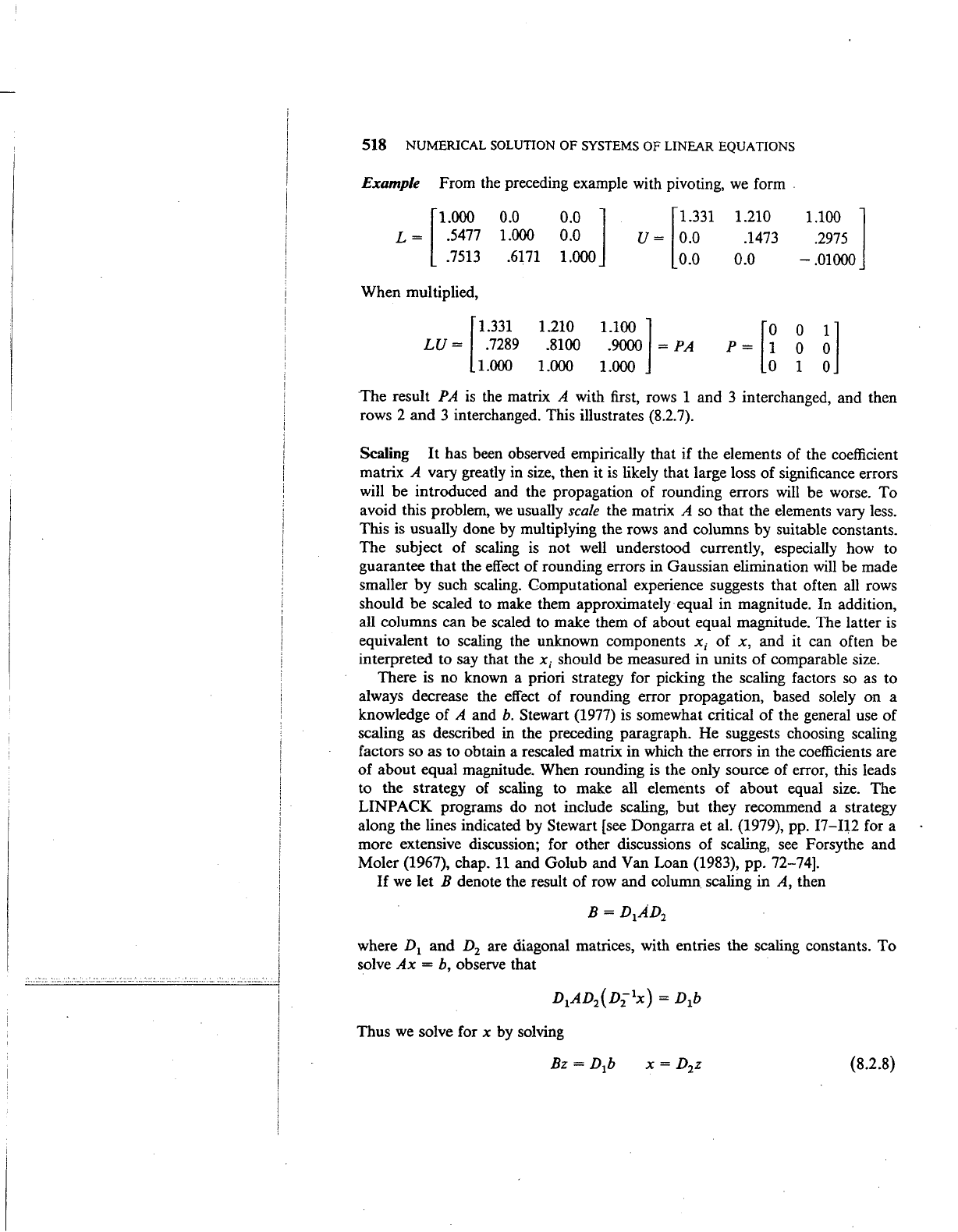
·'
·'··· ...
·'·
...... - .. ··-···-···
......
---·····-
····---·-···--
-··
---·-
........... .
518 NUMERICAL SOLUTION OF SYSTEMS OF LINEAR EQUATIONS
Example
From the preceding example with pivoting,
we
form .
rooo
0.0
0.0
l
[1.331
1.210
1.100
l
L = .5477
1.000
0.0
U=
0.0 .1473
.2975
.7513
.6171
1.000
0.0 0.0
-.01000
When multiplied,
r331
1.210
1.100]
p
~
[!
0
~]
LU
= .7289 .8100
.9000
=
PA
0
1.000
1.000
1.000 1
The
result
PA
is
the matrix A with first, rows 1 and 3 interchanged, and then
rows
2
and
3 interchanged. This illustrates (8.2.7).
Scaling
It
has been observed empirically that
if
the elements of the coefficient
matrix A vary greatly in size, then it
is
likely that large loss of significance errors
will be introduced and the propagation of rounding errors
will
be worse. To
avoid this problem,
we
usually scale the matrix A so that the elements vary less.
This is usually done
by
multiplying the rows and columns by suitable constants.
The subject of scaling
is
not well understood currently, especially how to
guarantee that the
effect
of rounding errors in Gaussian elimination
will
be made
smaller
by
such scaling. Computational experience suggests that often all rows
should be scaled to make them approximately equal in magnitude. In addition,
all columns can be scaled to make them of about equal magnitude. The latter
is
equivalent to scaling the unknown components
X;
of
x,
and it can often be
interpreted to say that the
X;
should be measured in units of comparable size.
There
is
no known a priori strategy for picking the scaling factors so
as
to
always decrease the effect of rounding error propagation, based solely on a
knowledge of
A and
b.
Stewart (1977) is somewhat critical of the general use of
scaling as described
in the preceding paragraph. He suggests choosing scaling
factors so as to obtain a rescaled matrix in which the errors in the coefficients are
of about equal magnitude. When rounding
is
the only source of error, this leads
to the strategy of scaling to make all elements of about equal size. The
UNPACK
programs do not include scaling,
but
they recommend a strategy
along the lines indicated by Stewart
(see
Dongarra et al. (1979), pp.
17-Il2
for a
more extensive discussion; for other discussions of scaling,
see
Forsythe and
Moler
(1967), chap.
11
and Golub and Van Loan (1983), pp. 72-74].
If
we
let B denote the result of row and column. scaling in A, then
B = D
1
AD
1
where D
1
and D
2
are diagonal matrices, with entries the scaling constants. To
solve
Ax
= b, observe that
Thus
we
solve for x
by
solving
Bz
= D
1
b
(8.2.8)
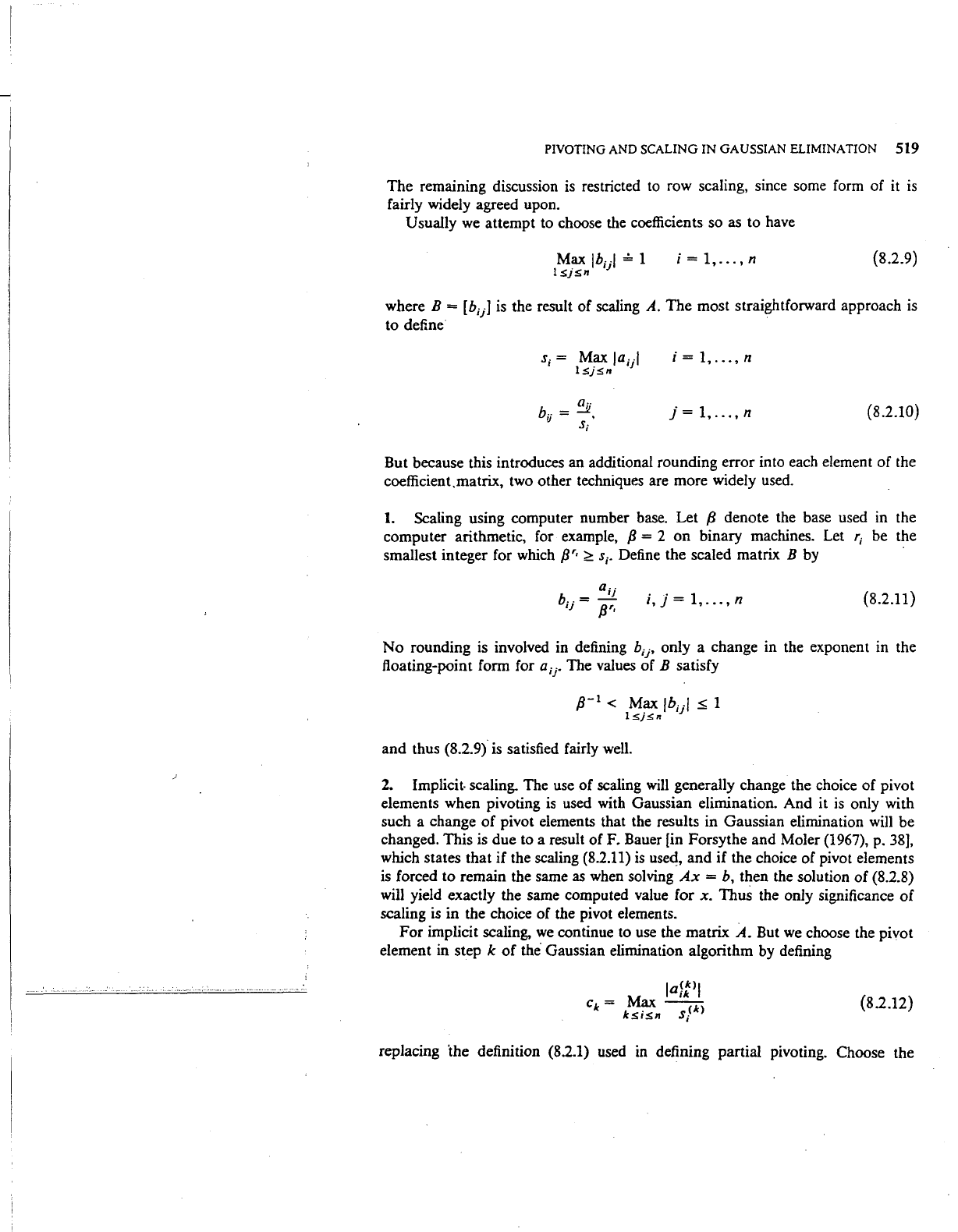
PIVOTING AND SCALING
IN
GAUSSIAN ELIMINATION 519
The remaining discussion
is
restricted to row scaling, since some form of it
is
fairly widely agreed upon.
Usually
we
attempt to choose the coefficients so as to have
Max
lh·-1
~
1
1s;js;n
'J
i = 1,
...
, n (8.2.9)
where B = [b;) is the result
of
scaling A.
The
most straightforward approach
is
to define
s; = Max
jaiil
1
Sj
s;
n
b
..
=~
u •
S;
i = 1,
...
, n
j = 1,
...
, n (8.2.10)
But because this introduces an additional rounding error into each element
of
the
coefficient.matrix, two other techniques are more widely used.
1.
Scaling using computer number base. Let
fJ
denote the base used in the
computer arithmetic, for example,
fJ
= 2
on
binary machines. Let r; be the
smallest integer for which
fJ'•
~
s;.
Define the scaled matrix B by
a;j
b ..
=-
,,
P'·
i,j=1,
...
,n
(8.2.11)
No
rounding is involved in defining
bij•
only a change in the exponent in the
floating-point form for
a;j·
The values
of
B satisfy
p-
1
< Max
lhiil
.s:
1
1
sjs
n
and
thus (8.2.9) is satisfied fairly
well.
2.
Implicit. scaling. The use
of
scaling
will
generally change the choice
of
pivot
elements when pivoting
is
used with Gaussian elimination. And it is only with
such a change
of
pivot elements that the results in Gaussian elimination will be
changed. This is due to a result
of
F. Bauer [in Forsythe and Moler (1967), p.
38),
which states that
if
the scaling (8.2.11)
is
used,
and
if
the choice
of
pivot elements
is forced to remain the same as when solving
Ax
= b, then the solution
of
(8.2.8)
will yield exactly the same computed value for x. Thus the only significance
of
scaling
is
in the choice
of
the pivot elements.
For
implicit scaling,
we
continue to use the matrix
A.
But
we
choose the pivot
element in step k
of
the·
Gaussian elimination algorithm by defining
(8.2.12)
replacing
the
definition (8.2.1) used
in
defining partial pivoting. Choose the
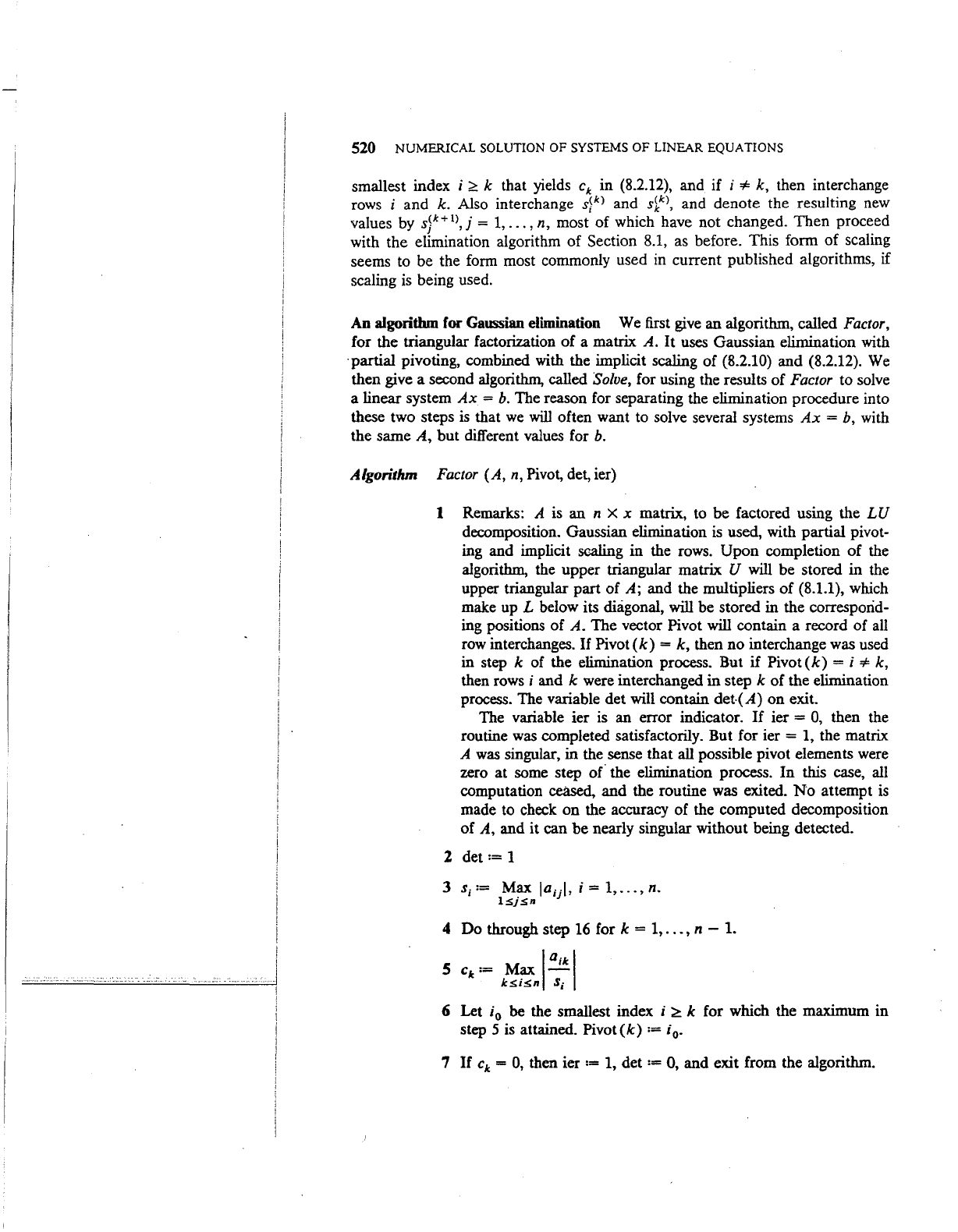
520 NUMERICAL SOLUTION OF SYSTEMS OF LINEAR EQUATIONS
smallest index i
:2::
k that yields
c"
in (8.2.12), and if i
=I=
k, then interchange
rows
i and k. Also interchange
s~"l
and
s~kl,
and denote the resulting
new
values
by
s~k+
1
l,
j =
1,
...
, n, most of which have not changed.
Then
proceed
with the elimination algorithm of
Section 8.1,
as
before. This form of scaling
seems to be the form most commonly used in current published algorithms, if
scaling
is
being used.
An
algorithm for Gaussian elimination
We
first
give
an algorithm, called Factor,
for the triangular factorization of a matrix
A.
It uses Gaussian elimination with
·partial pivoting, combined with the implicit scaling of (8.2.10) and (8.2.12).
We
then give a second algorithm, called Solve, for using the results of Factor to solve
a linear system
Ax
=
b.
The reason for separating the elimination procedure into
these two steps
is
that
we
will often want to solve several systems
Ax
= b, with
the same
A,
but different values for
b.
Algorithm Factor (A, n, Pivot, det, ier)
1 Remarks:
A is an n X x matrix, to be factored using the
LU
decomposition. Gaussian elimination
is
used, with partial pivot-
ing and implicit
scaling in the rows. Upon completion of the
algorithm, the upper triangular matrix
U will be stored in the
upper triangular part of
A;
and the multipliers of (8.1.1), which
make up
L below its diagonal, will be stored in the correspond-
ing positions of
A.
The vector Pivot will contain a record of all
row interchanges.
If
Pivot (
k)
= k, then no interchange was used
in step
k of the elimination process. But if Pivot (
k)
= i
=1=
k,
then rows
i and k were interchanged in step k of the elimination
process. The variable det will contain
det-(A)
on
exit.
The variable ier
is
an error indicator.
If
ier =
0,
then the
routine
was
completed satisfactorily. But for ier = 1, the matrix
A
was
singular, in the sense that all possible pivot elements were
zero at some step
o{
the elimination process.
In
this case, all
computation
ceased, and the routine was exited.
No
attempt is
made to check
on
the accuracy of the computed decomposition
of
A, and it can be nearly singular without being detected.
2 det
:=
1
3
s
1
:=
Max
jaiil'
i = 1,
...
,
n.
l:Sj:Sn
4 Do through step
16
for k = 1,
...
, n - 1.
5
c"
:=
Max I
atk
I
k:Si:Sn
S
1
6 Let i
0
be
the smallest index i
:2::
k for which the maximum in
step
5
is
attained. Pivot (
k)
:=
i
0
•
7
If
c"
=
0,
then ier
:=
1, det
:=
0, and exit from the algorithm.
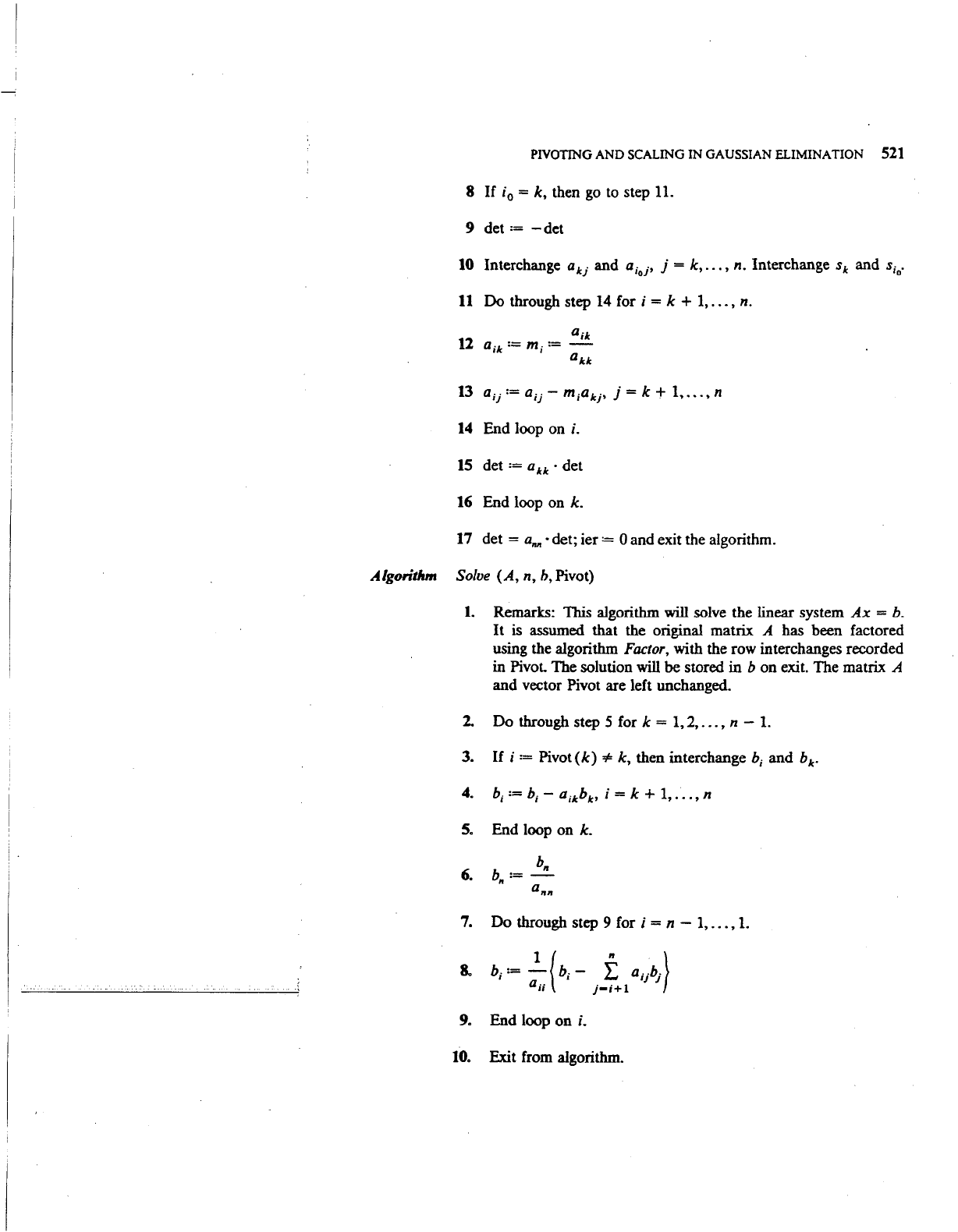
PIVOTING AND SCALING IN GAUSSIAN ELIMINATION 521
8
If
i
0
= k, then
go
to step
11.
9 det
:=
-det
10
Interchange
aki
and aioi' j = k,
...
,
n.
Interchange sk and
S;
0
11
Do
through step
14
for i = k +
1,
...
, n.
14
End loop on i.
15
det
:=au
· det
16
End loop on k.
17 det = a""· det; ier = 0 and exit the algorithm.
A.lgoritlun Solve (A, n, b, Pivot)
1.
2.
3.
4.
5.
6.
Remarks: This algorithm
will
solve the linear system
Ax
= b.
It
is
assumed that the original matrix A has been factored
using the algorithm
Factor, with the row interchanges recorded
in Pivot. The solution
will
be
stored in b on exit. The matrix A
and vector Pivot are left unchanged.
Do through step 5 for k =
1,
2,
...
, n -
1.
If
i
:=
Pivot(k) * k, then interchange
b;
and bk.
End loop on k.
b,.
b
:=-
"
a,.,.
7. Do through step 9 for i = n -
1,
...
,
1.
9. End loop on
i.
10.
Exit from algorithm.
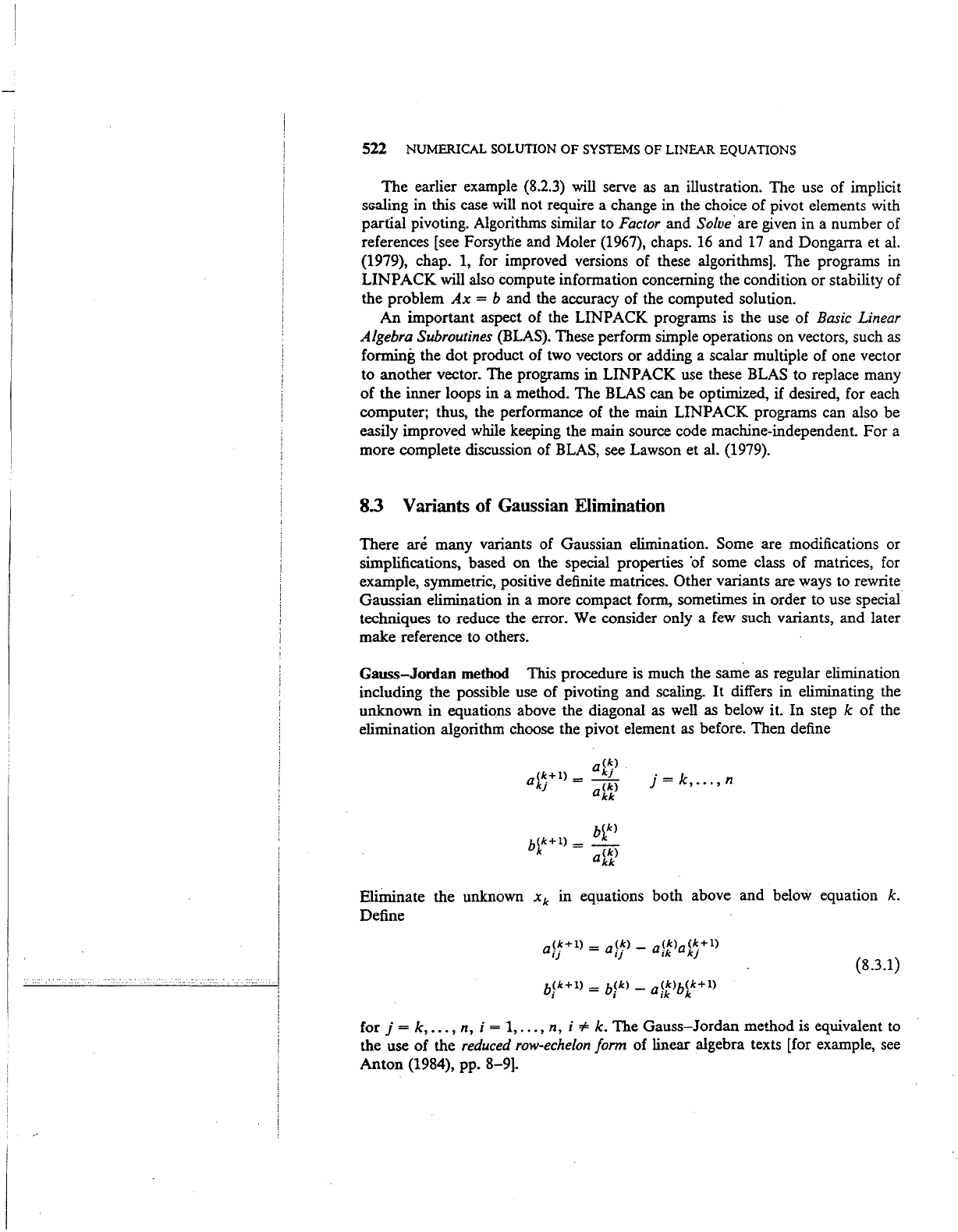
522 NUMERICAL SOLUTION
OF
SYSTEMS OF LINEAR EQUATIONS
The earlier example (8.2.3)
will
serve
as
an illustration. The use of implicit
saaling in this case
will
not require a change in the choice of pivot elements with
parfial pivoting. Algorithms similar to
Factor and Solve· are given in a number of
references [see Forsythe and Moler (1967), chaps.
16
and
17
and Dongarra et
al.
(1979), chap.
1,
for improved versions of these algorithms]. The programs in
UNPACK
will also compute information concerning the condition or stability of
the problem
Ax
= b and the accuracy of the computed solution.
An important aspect of the
UNPACK
programs is the use of Basic Linear
Algebra Subroutines
(BLAS). These perform simple operations on vectors, such
as
forming the dot product of two vectors or adding a scalar multiple of one vector
to another vector. The programs in
UNPACK
use these
BLAS
to replace many
of the inner loops in a method. The
BLAS
can be optimized, if desired, for each
computer; thus, the performance of the main
UNPACK
programs can also be
easily improved while keeping the main source code machine-independent.
For
a
more complete discussion of
BLAS,
see Lawson et al. (1979).
8.3 Variants of Gaussian Elimination
There are many variants of Gaussian elimination. Some are modifications or
simplifications, based on the special properties
"of
some class of matrices,
for
example, symmetric, positive definite matrices. Other variants are ways to rewrite
Gaussian elimination in a more compact form, sometimes in order to use special
techniques to reduce the error.
We
consider only a
few
such variants, and later
make reference to others.
Gauss-Jordan method This procedure is much the same
as
regular elimination
including the possible use of pivoting and scaling.
It
differs in eliminating the
unknown in equations above the diagonal
as
well
as
below it. In step k of the
elimination algorithm choose the pivot element
as
before. Then define
a<k>
a<k+l)
_
.21_
kj
-
a<k>
kk
b<{>
b(k+l)
=
--
k
a<k>
kk
j =
k,
...
, n
Eliininate the unknown xk in equations both above and below equation
k.
Define
a~~+l)
=a~~>-
a~kk>ak<~+l)
lj lj
l J
(8.3.1)
Mk+l>
=
Mk>-
a~kk>bk<k+l>
l l l
for j = k,
...
, n, i = 1,
...
,
n,
i * k. The Gauss-Jordan method is equivalent
to
the use of the reduced row-echelon form of linear algebra texts [for example,
see
Anton (1984), pp. 8-9].

VARIANTS
OF
GAUSSIAN ELIMINATION 523
This procedure
will
convert the augmented matrix
[A
ib]
to
[Jjb<n>],
so
that at
the completion of the preceding elimination,
x =
b<n>.
To
solve
Ax
= b by this
technique requires
{8.3.2)
multiplications and divisions. This
is
50
percent more than the regular elimina-
tion method; consequently, the Gauss-Jordan method should usually not be used
for solving linear systems. However, it can be used to produce a matrix inversion
program that
uses
a minimum of storage.
By
taking special advantage of the
special structure of the right side in
AX=
I,
the Gauss-Jordan method can
produce the solution
X=
A
-l
using only n extra storage locations, rather than
the normal n
2
extra storage locations. Partial pivoting and implicit scaling can
still
be
used.
Compact methods
It
is
possible to move directly from a matrix A to its
LU
decomposition, and this can be combined with partial pivoting and scaling.
If
we
disregard the possibility of pivoting for the moment, then the result
A
=LU
(8.3.3)
leads directly to a set of recursive formulas for the elements of
L and
U.
There
is
some non uniqueness in the choice of L and
U,
if
we
insist only that L
and U be lower and upper triangular, respectively.
If
A is nonsingular, and if we
have two decompositions
(8.3.4)
then
(8.3.5)
The inverse and the products of lower triangular matrices are again lower
triangular, and similarly for upper triangular matrices. The left and right sides of
(8.3.5) are lower and upper triangular, respectively. Thus they must equal
a·
diagonal matrix, call it
D,
and
(8.3.6)
The choice of
D
is
tied directly
to
the choice of the diagonal elements of either L
or
U,
and once they have been chosen, D
is
uniquely determined.
If
the diagonal elements of L are all required to equal 1, then the resulting
decomposition
A =
LU
is
that given by Gaussian elimination,
as
in Section 8.1.
The associated compact method
gives
explicit formulas for
l;j
and
uij•
and
it
is
known
as
Doolittle's method.
If
we
choose to have the diagonal elements of U all
equal
1,
the associated compact method for calculating A =
LU
is called Crout's
method.
There is only a multiplying diagonal matrix to distinguish it from
Doolittle's method. For an algorithm using Crout's algorithm for the factoriza-
